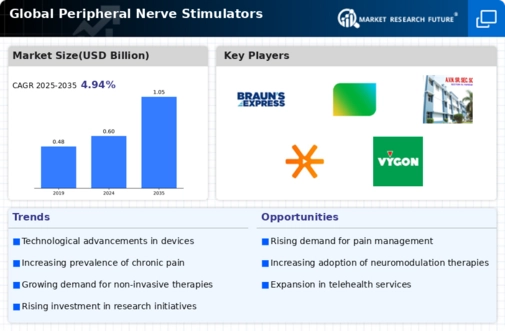Market Analysis
In-depth Analysis of Peripheral Nerve Stimulators Market Industry Landscape
The Peripheral Nerve Stimulators market is unveiling an innovative wireless device, representing a significant leap forward in the field. Unlike traditional devices, these wireless Peripheral Nerve Stimulators can transmit signals to the implanted electrode without the need for cumbersome wires. What sets these wireless devices apart is their elimination of the necessity for large batteries to be implanted in the body. This design enables physicians to monitor and manage the devices remotely, marking a notable advancement in the field of medical technology.
The adoption of wireless Peripheral Nerve Stimulators comes with a range of benefits that are poised to reshape the landscape of pain management. One of the primary advantages is the potential for shorter hospital stays. Traditional stimulators often require a significant recovery period due to the invasive nature of the procedures and the implantation of bulky internal batteries. In contrast, wireless devices reduce the need for extensive surgery, leading to quicker recovery times and shorter hospital stays for patients.
Moreover, the wireless nature of these Peripheral Nerve Stimulators diminishes the requirement for extensive anesthesia. Traditional procedures involving the implantation of wired stimulators can necessitate higher levels of anesthesia, contributing to increased risks and prolonged recovery. Wireless devices offer a more streamlined approach, minimizing the need for extensive anesthesia and promoting a safer and more comfortable experience for patients.
An additional advantage of wireless Peripheral Nerve Stimulators lies in the reduction of healthcare costs. The elimination of the need for internal batteries and the associated surgical procedures translates to a more cost-effective solution for patients and healthcare providers. The absence of invasive battery implantation procedures reduces the overall expenses related to surgery and post-operative care, making the wireless devices a financially viable option for both patients and the healthcare system.
The convenience and efficiency brought by wireless Peripheral Nerve Stimulators extend beyond reduced hospital stays, lower anesthesia requirements, and decreased healthcare costs. The remote monitoring and programming capabilities of these devices offer a level of control and adaptability that enhances patient care. Physicians can adjust and optimize the stimulator settings without the need for frequent in-person visits, providing a more patient-centric and flexible approach to pain management.
As a result, the demand for wireless Peripheral Nerve Stimulators is expected to experience substantial growth in the foreseeable future. The transformative advantages offered by these devices align with the evolving needs of patients and healthcare providers, driving the market toward a new era of pain management technology. The wireless approach not only enhances patient comfort and safety but also represents a paradigm shift in the way Peripheral Nerve Stimulators are utilized, positioning them as a pivotal component in the future of medical technology.








Leave a Comment